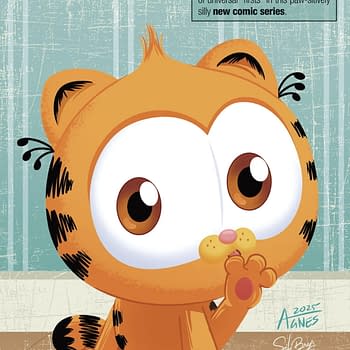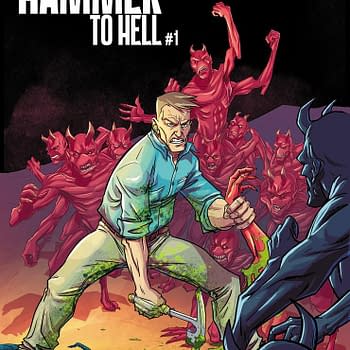Posted in: Comics | Tagged: Comics, entertainment
Violent Love's Frank Barbiere -"What Do Dangerous, Interesting Individuals Perceive Love To Be?"
Violent Love, the forthcoming Image series by Frank Barbiere, Victor Santos, and Dylan Todd, is already being roundly praised by various news outlets. The whole concept has turned peoples' heads—as seminal as a crime duo seems to modern storytelling, it's been awhile since we saw a comic presented in such basic terms. A comic that promises that a relationship will be at the center of an edgy criminal enterprise, and also to present the story with a level of style and flair deserved by the subject matter.
Barbiere and Santos have worked together before, on the Boom series Black Market, but their separate works show even more of the genesis of this project. Barbiere's pulp genre celebration, Five Ghosts, sets the stage for his work, followed by other genre explorations like Solar: Man of the Atom (Dynamite), Blackout (Dark Horse), Broken World (Boom), Avengers (Marvel), The White Suits (Dark Horse), and The Revisionist (Aftershock). For awhile, his work has moved steadily through traditional science fiction and touched on superhero tradition, but those who read The White Suits may have suspected he had more gangster tales to tell.
Victor Santos' best known works in the USA are the Polar trilogy of landscape format hardcovers tracking spies and hitmen from Dark Horse, a revelation in ink and spot color, greatly respected among fans and comics pros alike. I had the pleasure of working with Santos on the third volume of Polar, No Mercy for Sister Maria, during my time at Dark Horse.
Hearing that Santos and Barbiere were teaming up on a series inspired by true crime made perfect sense, but it's not a match to take for granted—both have a specific history working with crime stories, and both seem to find what may be their strongest creative impulses in that genre. The fact that they've managed to collaborate on Violent Love as a purely creator-owned series gives fans a chance to see just how deep these creative inclinations run.
Violent Love tells the story of Daisy, Roc, and their criminal career together. The first issue introduces us to the legend of this criminal couple, but also takes us far into Daisy's backstory establishing a level of motivation I rarely see in comics these days, since the focus on immediate action in the first issue of a comic is usually espoused by publishers and creators alike. For that reason, the series establishes an almost novelistic level of connection with the reader right away.
I spoke with Frank Barbiere about Violent Love, and as usual when I speak to Frank about his work, his thoughts on the comic turned out to be even more carefully considered than I had originally supposed them to be.
Hannah Means-Shannon: Mr. Barbiere, I've read the first issue of Violent Love, and I suspect this comic was written by you for the following reason: the reader thinks they're going to get this entertaining little genre-specific story and instead they get way more emotionally involved with the characters than they expected to. What gives? It's like you think a story can be both entertaining and meaningful or something.
But in all seriousness, the first issue does have some really elegant structural elements that introduce us to Daisy's background and story. And you spend a very compellingly long first issue making sure we understand her. It would have been a more common comic manoeuvre to cram her backstory into about two pages and then jump right into a chase scene or something equally active. Why did you choose to do otherwise?
Frank Barbiere: Victor and I really want this story to have legs, and we can't do anything if you don't care about our characters. While this is a love story about a bank-robbing couple, Daisy is our lead–I really wanted to spend the time to give her a proper introduction. One of the great things about working with Image is that we aren't constrained by page count; I'm very glad we have an extra-long (34 pages, respectively) opening chapter and hope it really hooks readers into Daisy's story and our world.
In a larger story sense, I've become very fascinated with frame stories and how they work in fiction. When Victor and I started working on Violent Love I very quickly decided this would be the perfect opportunity to include a framing sequence–that being having the old man Lou talking with the young girl, Penny. One of the big parts of this story is giving it both a "true crime" and "folk tale" feel. By having the main part of the story narrated, it adds to that effect and hits the tonal notes we're going for. The frame story has a very specific purpose, and I hope readers will be intrigued by the way we're telling this story.
I'm also excited to open our story at the beginning, rather than having to jump to the most exciting moment to hook readers. It's an audacious move, but we hope our potential readers will be more invested in the long run rather than just giving them the hook of the book upfront.

FB: I'd say that modern crime comics like Powers and Criminal are the reasons I ended up pursuing writing in the medium, so this is where I've been slowly heading. I'm a huge fan of genre (and as you can see by my creator-owned catalogue I've been working my way through many different genres) but I'm constantly intrigued by moral ambiguity and the gray areas characters in extraordinary circumstances are forced to deal with. Crime has always done this particular element well, and it finally felt right to me to do a story grounded in reality, without the necessary hook of the supernatural or spectacular.
The addition of a love story really helps ground our story and set it apart. This is very much a tale of two people dealing with extraordinary circumstances (in the criminal sense), coming together, and learning how to love one another. The relationship between Daisy and Rock is the center of our story, despite whatever plot machinations turn–it's been about making the stakes around that element high and keeping it interesting. I enjoy the challenge of stepping out of my comfort zone, and all these elements plus a "true crime" feel have really given me a whole new context to work in. It's exciting! Of course it's all held together by Victor's incredible artwork and storytelling, so I have quite a safety net, haha.
HMS: For me, as a reader, true crime has the power to disturb me possibly more than any other genre. And knowing that this story was "inspired" by true events made me experience the first issue differently. How does the weight of "true" elements affect you as a writer? Is it a more emotional experience for you?
FB: Our story is rooted in what we'll definitely call "faux true crime," wherein it's not a retelling of any specific event, but very much inspired by different things. But speaking more to the question, it is a story grounded in reality, and I think that really does give it a weight not present in some totally fictional, guns-blazing, action comics. When characters are hurt or killed in the world of Violent Love, they're dead. There are consequences and fear. The violence in our book is definitely going to be portrayed in a graphic (even bombastic at times) fashion, but it truly is about consequences, and quite frankly meant to be a little frightening.
I've told a story about the first time I saw an adult "fight" in real life that quickly went bad, blood being drawn–it was horrifying. We are inundated with fantasy violence, but in the real world it's something that is sickening and terrifying. Without being exploitive, that's the emotion I want to portray more than the entertainment factor. This doesn't set out to shock, but it's there to remind readers that this is not a game for our characters, it's literally life or death. Coupled with the other end of the spectrum (love and romance) this is a very emotional story, and hopefully will evoke some thoughts about both violence and love in our readers.

FB: As I mentioned, I am drawn to stories about people who are morally ambiguous/forced to make difficult moral choices. While there are many great stories about traditionally "good" heroes, I think it's always more compelling to understand a character's motivations and then watch them struggle to "do the right thing". Whether that action is morally good or bad, that's up to the reader to decide. The joy in this series will come from subverting reader expectations–yes, we're leaning on some genre conventions, but working very hard to keep them twisting and turning to create a compelling story you haven't seen before. Meanwhile, we're working thematically towards larger ideas of love, violence, and morality. It sounds lofty, but this is what I love about story and what a project like this represents to me. Again, it doesn't hurt that it's all wrapped up in beautiful artwork by Victor, but it's truly a love letter to some of our favorite genres and eras, and we want to make sure it says something substantial.
HMS: This story starts (and perhaps finishes) in Texas, and so far includes California. Is this in part a "western"? What kind of traditions do these locations encourage you to tap into?
FB: Violent Love is very much a western in spirit. While leaning into our crime/pulp influences, the western inevitably rears its head and we want to lean into it as well. The Cohen Bros. have been a huge inspiration with films like Fargo, No Country for Old Men, and True Grit, so we feel both the period and visual tone of the series can evoke both nostalgia and a loving tip of the hat to our influences. Victor was been so smart in his use of space and color on the page to evoke tone and feeling; he truly has taken the project to new heights. We both know what we want out of this project, and that's the best way to get great results in any collaboration.
HMS: What does the phrase "criminal romance" mean to you? Why do you think the legends of criminal couples have lodged in the American imagination so much?
FB: The idea of criminals in love is certainly not a new one, but I think it's something that hasn't been done to death in the comics space. The genre of the love story is intriguing from a "story mechanics" point of view and I'm just so taken by the idea of mashing that together with a crime/action story. That's a little inside baseball, haha, but it's the kind of thing that interest me. In terms of "criminal romance," I really am trying to show what these dangerous, interesting individuals perceive love to be–is it a means to an end? Is it a tool to get what they want? What does it mean for them to be a couple?
Ultimately, the big question is if they are going to use this romance to create something great or burn things to the ground. I think our opening prologue might be indicative of how things turn out for our couple, but as I said–we're all about subverting expectations, so you'll have to keep reading to find out!
Violent Love #1 reaches FOC from Image Comics on Monday, October 17th, and is currently listed in Previews World here with order code: SEP160635
Stay tuned for the second part of this interview, a discussion with Victor Santos, to follow on Bleeding Cool!














